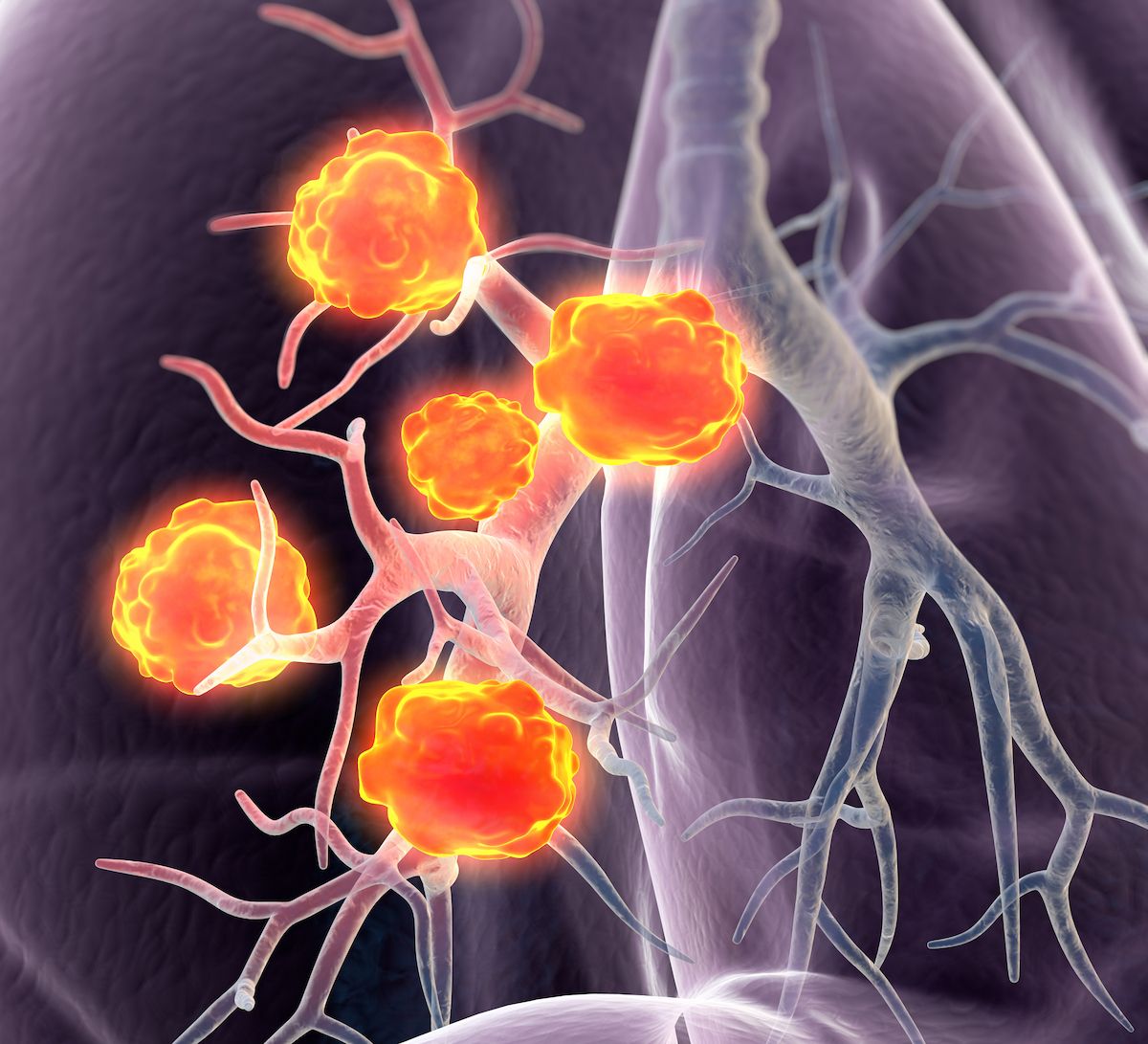HTMC0435 Plus Chemotherapy Yields Responses in Relapsed ES-SCLC
HTMC0435 plus temozolomide led to an ORR of 24.5%, with a median OS of 12.0 months, in patients with platinum-sensitive and platinum-resistant small cell lung cancer.
HTMC0435 plus temozolomide led to an ORR of 24.5%, with a median OS of 12.0 months, in patients with platinum-sensitive and platinum-resistant small cell lung cancer.

Combining the oral PARP inhibitor HTMC0435 with temozolomide (Temodar) led to promising antitumor activity and a manageable safety profile in patients with platinum-sensitive and platinum-resistant extensive-stage small cell lung cancer (ES-SCLC), according to results from a phase 1b/2 trial (NCT05728619) shared at the 2025 American Society of Clinical Oncology Annual Meeting.1
As of October 31, 2024, with a median follow-up of 10.3 months among all evaluable patients (n = 49), the objective response rate (ORR) was 24.5% (95% CI, 12.0%-37.0%) and the disease control rate (DCR) was 63.3% (95% CI, 49.3%-77.3%). There were 12 confirmed and 7 unconfirmed partial responses (PRs); of the 19 patients with PRs, 3 were still undergoing treatment. The median duration of response (DOR) was 6.9 months (95% CI, 1.22-12.58).
The median progression-free survival (PFS) was 2.8 months (95% CI, 1.16-4.44), and the median overall survival (OS) was 12.0 months (95% CI, 7.85-14.75).
In patients without brain metastases (n = 26), the ORR was 38.5% (95% CI, 20.2%-59.4%) and the DCR was 61.5% (95% CI, 40.6%-79.8%); the median DOR was 5.5 months (95% CI, 3.65-not calculable [NC]). The median PFS was 2.7 months (95% CI, 1.41-5.52), and the median OS was 12.0 months (95% CI, 8.11-NC).
In patients with platinum-resistant disease (n = 23), defined as a chemotherapy-free interval of less than 90 days, the ORR was 25.0% (95% CI, 8.7%-49.1%) and the DCR was 55.0% (95% CI, 31.5%-76.9%); the median DOR was not reached. The median PFS was 2.5 months (95% CI, 1.38-5.03), and the median OS was 12.6 months (95% CI, 5.78-NC). The 3-month OS rate was 91.3% (95% CI, 69.5%-97.8%), and the 6-month OS rate was 69.6% (95% CI, 46.6%-84.2%).
In patients with platinum-sensitive disease (n = 29), defined as a chemotherapy-free interval of 90 days or more, the ORR was 26.9% (95% CI, 11.6%-47.8%) and the DCR was 73.1% (95% CI, 52.2%-88.4%); the median DOR was 4.2 months (95% CI, 4.14-NC). The median PFS was 4.2 months (95% CI, 2.69-5.52), and the median OS was 11.2 months (95% CI, 8.38-NC).
“Treatment options for ES-SCLC in [the] second-line setting are limited,” wrote first study author Yun Fan, MD, of Zhejiang Cancer Hospital in Hangzhou, China, and coauthors in the presentation. “This combination of HTMC0435 and [temozolomide] showed promising antitumor activity and manageable safety both in [patients with] platinum-sensitive and platinum-resistant SCLC.”
The trial enrolled a total of 59 eligible patients with ES-SCLC who had progression after first- or second-line therapy. The trial was broken into 2 parts: a multicenter dose-escalation stage to evaluate safety and pharmacokinetics and a multicenter dose-expansion stage to evaluate preliminary efficacy.
In both stages, patients had histologically or cytologically confirmed recurrent or progressive ES-SCLC that was previously treated with 1 or 2 lines of therapy. Treatment also continued until disease progression or intolerable toxicity.
In the dose-escalation phase, a total of 4 patients received 16 mg of HTMC0435 in 8-mg doses twice daily and 75 mg/m2 of temozolomide once daily on days 1 to 7 of each 21-day cycle and a total of 3 patients received 12 mg of HTMC0435 in 6-mg doses twice daily and 75 mg/m2 of temozolomide once daily on days 1 to 7 of each 21-day cycle.
In the dose-expansion phase, a total of 52 patients received 16 mg of HTMC0435 in 8-mg doses twice daily and 75 mg/m2 of temozolomide once daily on days 1 to 7 of each 21-day cycle.
The recommended phase 2 dose (RP2D) was chosen to be HTMC0435 at 8 mg twice daily. Of patients who received the RP2D, brain and liver metastases were observed in 41.8% and 23.6% of patients, respectively. Additionally, 61.8% of patients received prior platinum-based and anti–PD-(L)1 therapy in the first-line setting.
The trial’s objectives were to evaluate the safety, pharmacokinetics, and preliminary efficacy of the treatment regimen.
Regarding safety, treatment-related adverse events (TRAEs) of any grade occurred in 69.6% of patients and TRAEs of grade 3 or 4 occurred in 55.9%. The most common TRAEs of grades 3 and 4 were neutropenia (35.6%), leukopenia (28.8%), thrombocytopenia (13.6%), and anemia (8.5%). TRAEs led to dose reduction of HTMC0435 in 10.2% of patients and treatment discontinuation in none.
Reference
Fan Y, Li H, Huang Z, et al. Efficacy and safety of HTMC0435 combination with temozolomide in relapsed extensive-stage small-cell lung cancer (ES-SCLC): a phase Ib/II study. J Clin Oncol. 2025;43(suppl 16):8097. doi:10.1200/JCO.2025.43.16_suppl.8097